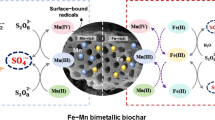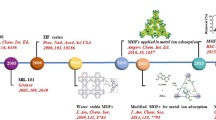Abstract
Natural phosphorus-ferromanganese ore (NPO-NFMO) based composites by mechanical ball milling method, applying for the simultaneous remediation of arsenic (As) and lead (Pb) co-contaminated groundwater. Kinetic behavior adopted pseudo-second-order adsorption mechanism attaining equilibrium in 120 min over a wide pH range (2.0–6.0). NPO-NFMO realized higher adsorption capacity for As(III) (6.8 mg g−1) and Pb(II) (26.5 mg g−1) than those of single NPO (1.7 and 7.8 mg g−1) and NFMO (2.9 and 5.1 mg g−1), indicating that synergistic effects of NPO and NFMO considerably enhanced the adsorption capacity in mixed adsorption system. Fresh and used NPO-NFMO were characterized, and indicated that NPO-NFMO formed stable minerals of PbAs2O6 and PbFe2(AsO4)2(OH)2. The underlying adsorption mechanism indicated that As(III) and Pb(II) removal was involved with multiple mechanisms, including electrostatic adsorption, oxidation, complexation, and coprecipitation. The effects of key reaction parameters including mass ratios of NPO and NFMO, initial metal ion concentration, dosage, solution pH, and co-existing anions in groundwater were systematically investigated. The novel designed NPO-NFMO-based composites can be deemed as a promising amendment for simultaneous immobilization of As(III) and Pb(II) in co-contaminated soil and groundwater.













Similar content being viewed by others
Data availability
The datasets used and/or analyzed during the current study are available from the corresponding author on reasonable request.
References
Ain QU, Zhang H, Yaseen M et al (2020) Facile fabrication of hydroxyapatite-magnetite-bentonite composite for efficient adsorption of Pb(II), Cd(II), and crystal violet from aqueous solution. J Clean Prod 247:119088
Akin I, Arslan G, Tor A, Ersoz M et al (2012) Arsenic(V) removal from underground water by magnetic nanoparticles synthesized from waste red mud. J Hazard Mater 235–236:62–68
Asri SE, Laghzizil A, Coradin T et al (2010) Conversion of natural phosphate rock into mesoporous hydroxyapatite for heavy metals removal from aqueous solution. Colloids Surf A Physicochem Eng Asp 362(1):33–38
Bhaumik M, Maity A, Brink (2021) Zero valent nickel nanoparticles decorated polyaniline nanotubes for the efficient removal of Pb(II) from aqueous solution: Synthesis, characterization and mechanism investigation. Chem Eng J 417:127910
Bhowmick S, Chakraborty S, Mondal P et al (2014) Montmorillonite-supported nanoscale zero-valent iron for removal of arsenic from aqueous solution: Kinetics and mechanism. Chem Eng J 243:14–23
Chen J, Wang J, Zhang G et al (2018) Facile fabrication of nanostructured cerium-manganese binary oxide for enhanced arsenite removal from water. Chem Eng J 334:1518–1526
Cheng Z, Fu F, Dionysiou D et al (2016) Adsorption, oxidation, and reduction behavior of arsenic in the removal of aqueous As(III) by mesoporous Fe/Al bimetallic particles. Water Res 96:22–31
Cui H, Dong T, Hu L et al (2022) Adsorption and immobilization of soil lead by two phosphate-based biochars and phosphorus release risk assessment. Sci Total Environ 824:153957
Depalma S, Cowen S, Hoang T et al (2008) Adsorption thermodynamics of p-Arsanilic acid on iron (oxyhydr) oxides: in-situ ATR-FTIR studies. Environ Sci Technol 42(6):1922–1927
Feng W, Liu G, Wang P et al (2020) Template synthesis of a heterostructured MnO2@SnO2 hollow sphere composite for high asymmetric supercapacitor performance. ACS Appl Energy Mater 3(8):7284–7293
Gao J, Wang W, Rondinone AJ et al (2015) Degradation of trichloroethene with a novel ball milled Fe-C nanocomposite. J Hazard Mater 300:443–450
Goldberg S, Johnston CT (2001) Mechanisms of arsenic adsorption on amorphous oxides evaluated using macroscopic measurements, vibrational spectroscopy, and surface complexation modeling. J Colloid Interface Sci 234(1):204–216
Guan X, Dong H, Ma J et al (2009) Removal of arsenic from water: effects of competing anions on As (III) removal in KMnO4-Fe(II) process. Water Res 43(15):3891–3899
Gude JCJ, Rietveld LC, Van Halem D (2017) As(III) oxidation by MnO2 during groundwater treatment. Water Res 111:41–51
He Y, Fang T, Wang J et al (2022) Insight into the stabilization mechanism and long-term effect on As, Cd, and Pb in soil using zeolite-supported nanoscale zero-valent iron. J Clean Prod 355:131634
Hu J, Li S, Chu J et al (2019) Understanding the phase-induced electrocatalytic oxygen evolution reaction activity on FeOOH nanostructures. ACS Catal 9(12):10705–10711
Jain CK, Ali I (2000) Arsenic: occurrence, toxicity and speciation techniques. Water Res 34(17):4304–4312
Jia Y, Xu L, Wang X (2007) Infrared spectroscopic and X-ray diffraction characterization of the nature of adsorbed arsenate on ferrihydrite. Geochim Cosmochim Acta 71(7):1643–1654
Lenoble V, Laclautre C, Serpaud B et al (2004) As(V) retention and As(III) simultaneous oxidation and removal on a MnO2-loaded polystyrene resin. Sci Total Environ 326(1):197–207
Li S, Yan W, Zhang WX (2009) Solvent-free production of nanoscale zero-valent iron (nZVI) with precision milling. Green Chem 11(10):1618–1626
Liao J, Xiong T, Ding L et al (2022) Design of a renewable hydroxyapatite-biocarbon composite for the removal of uranium (VI) with high-efficiency adsorption performance. BCHA 4(1):1–18
Ma QY, Logan TJ, Traina SJ et al (1994) Effects of NO3-, Cl-, F-, SO42-, and CO32- on Pb2+ immobilization by hydroxyapatite. Environ Sci Technol 28(3):408–418
Meng K, Wu X, Zhang X et al (2019) Efficient adsorption of the Cd(II) and As(V) using novel adsorbent ferrihydrite/manganese dioxide composites. ACS Omega 4(20):18627–18636
Pena M, Meng X, Korfiatis GP et al (2006) Adsorption mechanism of arsenic on nanocrystalline titanium dioxide. Environ Sci Technol 40(4):1257–1262
Qureshi SS, Memon SA, Ram N et al (2022) Rapid adsorption of selenium removal using iron manganese-based micro adsorbent. Sci Rep 12(1):1–13
Shi K, Radhakrishnan M, Dai X et al (2021) NemA catalyzes trivalent organoarsenical oxidation and is regulated by the trivalent organoarsenical-selective transcriptional repressor NemR. Environ Sci Technol 55(9):6485–6494
Stumm W, Morgan J (1996) Aquatic chemistry. In: Chemical equilibria and rates in natural waters 3rd edn. New York: Wiley-Interscience, p 462–466
Sun Y, Yu IKM, Tsang DCW et al (2019) Multifunctional iron-biochar composites for the removal of potentially toxic elements, inherent cations, and hetero-chloride from hydraulic fracturing wastewater. Environ Int 124:521–532
Wang L, Cho DW, Tsang DCW et al (2019) Green remediation of As and Pb contaminated soil using cement-free clay-based stabilization/solidification. Environ Int 126:336–345
Wang YN, Tsang YF, Wang H et al (2020) Effective stabilization of arsenic in contaminated soils with biogenic manganese oxide (BMO) materials. Environ Pollut 258:113481
Wang H, Chen Q, Liu R et al (2022) Synthesis and application of starch-stablized Fe-Mn/biochar composites for the removal of lead from water and soil. Chemosphere 305:135494
Xia Q, Lamb D, Peng C et al (2017) Interaction effects of As, Cd and Pb on their respective bioaccessibility with time in co-contaminated soils assessed by the Unified BARGE Method. Environ Sci Pollut Res 24(6):5585–5594
Zhang Y, Yang M, Dou XM et al (2005) Arsenate adsorption on an Fe-Ce bimetal oxide adsorbent: role of surface properties. Environ Sci Technol 39(18):7246–7253
Zhang G, Qu J, Liu H et al (2007) Preparation and evaluation of a novel Fe-Mn binary oxide adsorbent for effective arsenite removal. Water Res 41(9):1921–1928
Zhang L, Fu Z, Wu Z et al (2014) Investigation of structural and luminescent properties of Ce3+/Mn2+ ions-doped Ca5(PO4)3F. Mater Res Bull 56:65–70
Zhang G, Liu Y, Wang J et al (2020) Efficient arsenic(III) removal from aqueous solution by a novel nanostructured iron-copper-manganese trimetal oxide. J Mol Liq 309:112993
Funding
This research has been financially supported by the National Key Research and Development Program “Soil Pollution and Control Technology from the Ministry of Science and Technology of China” (Grant No. 2020YFC1808000 and 2019YFC1806200).
Author information
Authors and Affiliations
Contributions
Hongli Lu: performing experiments, data analysis and processing. Xiangjian Xu: funding acquisition, resources and supervision. Yu Yang: funding acquisition, resources and supervision. Fu Xia: performing experiments, data analysis and processing. Xu Han: writing—review and editing. Han Xiao: writing—review and editing. Yonghai Jiang: funding acquisition, resources and supervision. Sheng Deng: writing—review and editing. Shuxuan Wu: data analysis and processing. Xingang Wang: performing experiments, data analysis and processing. Qinghua Yan: Resources and supervision.
Corresponding author
Ethics declarations
Ethical approval and consent to participate
Not applicable.
Consent to publish
Not applicable.
Competing interests
The authors declare no competing interests.
Additional information
Responsible Editor: Ioannis A. Katsoyiannis
Publisher's Note
Springer Nature remains neutral with regard to jurisdictional claims in published maps and institutional affiliations.
Responsible Editor: Ioannis A. Katsoyiannis.
Supplementary Information
Below is the link to the electronic supplementary material.
Rights and permissions
Springer Nature or its licensor (e.g. a society or other partner) holds exclusive rights to this article under a publishing agreement with the author(s) or other rightsholder(s); author self-archiving of the accepted manuscript version of this article is solely governed by the terms of such publishing agreement and applicable law.
About this article
Cite this article
Lu, H., Xu, X., Yang, Y. et al. Natural phosphorus-ferromanganese ore-based composites for the simultaneous remediation of arsenic- and lead-co-contaminated groundwater: synergistic effectiveness, kinetics, and mechanisms. Environ Sci Pollut Res 30, 102446–102461 (2023). https://doi.org/10.1007/s11356-023-29475-9
Received:
Accepted:
Published:
Issue Date:
DOI: https://doi.org/10.1007/s11356-023-29475-9




